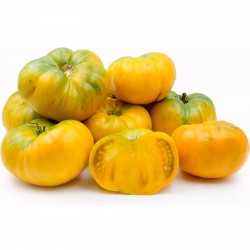- -15%
- New

Variety from Russia






This plant produces good yields golden-orange tomatoes weighing from 1-2 lbs. This fruit has a mild sweet flavor, meaty in texture, and have relatively few seeds. This variety originated in Russia. Determinate. Plant reaches 3 ft in height. 80 days.
This plant produces good yields golden-orange tomatoes weighing from 1-2 lbs. This fruit has a mild sweet flavor, meaty in texture, and have relatively few seeds. This variety originated in Russia. Determinate. Plant reaches 3 ft in height. 80 days.
The Persimmon tomato is a golden fruit the color of an egg yolk. Its rich flesh is the same lively color of the skin. Because the Persimmon tomato’s seed cavities are very small it has a higher concentration of solid flesh than many other varieties. It has a marvelous flavor—low in acidity, creamy, and fruity. Unlike so many heirloom tomatoes, persimmons have skin that is resistant to cracking. This quality, along with its flavor and short growing season, make this a coveted cultivar for farmers and gardeners. Persimmon tomatoes typically weigh between one and two pounds.
Data sheet